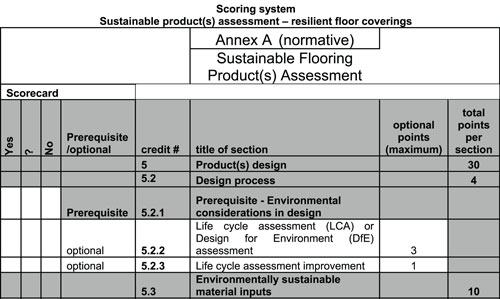Assessing Resilient Flooring for Sustainability: Introducing a New Standard
Prerequisites Required to Conduct an Assessment
Four of the six assessment categories in NSF 332 contain a total of 11 specific prerequisites that are minimum threshold requirements under the standard. Manufacturers using the standard to demonstrate sustainability of their product must first meet all of the prerequisites in each category in order to proceed any further. Once all 11 prerequisites are met, they may then seek points toward the Sustainable Product(s) Achievement levels (Conformant, Silver, Gold or Platinum) by meeting the additional specified scoring criteria within the six categories. Note that the prerequisites as described below do not carry any points, rather they are intended to establish the minimum qualifying baseline criteria from which a product can then be judged further for sustainability under NSF 332.
The first three prerequisites are in the Product Design Category as follows:
Environmental considerations in design. The manufacturer must implement an environmental assessment program within the product(s) design and development system. The program shall consider the environmental attributes and impacts of its products and packaging, including issues such as designing for longevity, designing for reusability, and designing for recyclability and/or compostability. The environmental assessment program shall consider environmental attributes and impacts of products and packaging across the entire product's life cycle (e.g., raw material extraction, manufacturing, use and end of life).
Inventory of material inputs. The manufacturer must complete an inventory of material inputs for the product(s) undergoing assessment including packaging and recommended adhesive systems. At a minimum, the inventory shall report inputs by using Chemical Abstract Service (CAS) nomenclature, with inputs classified as hazardous declared to a minimum 1000 ppm (0.1 percent) threshold and other inputs to 10,000 ppm (1.0 percent) threshold. The manufacturer shall also document the environmentally sustainable nature of the materials (e.g. recycled [pre- or post-consumer], bio-based, environmentally preferable).
Identification of use of chemicals of concern. The manufacturer must create a report classifying the raw material inputs for the product(s) undergoing assessment, including recommended adhesives, by the chemical hazard classification listed below.
At a minimum, the manufacturer must report whether the raw material input comprising at least 1000 ppm of the product(s) or adhesive is classified by any of the following: (1) the International Agency on the Research of Cancer (IARC) as a human carcinogen (Group 1) or probable human carcinogen (Group 2A); (2) the National Toxicology Program (NTP) as a known human carcinogen or reasonably anticipated carcinogen; (3) the U.S. Occupational Safety and Health Administration (OSHA) as a regulated toxic metal or carcinogen; (4) California Proposition 65 as a carcinogen or reproductive toxin; (5) U.S. EPA as a Persistent, Bioaccumlative, and Toxic (PBT) chemical; (6) U.S. EPA as a Toxic Release Inventory (TRI) toxic chemical or compound; (7) U.S. EPA as a RCRA Waste Minimization priority chemical; (8) U.S. and Canada as a Great Lakes Binational Toxics Strategy chemical; (9) the Stockholm Convention as a Persistent Organic Pollutant (POP); and (10) the European Union as a hazardous substance subject to the Restriction of Hazardous Substances (RoHS) directive.
Three prerequisites fall under the category of Product Manufacturing as follows:
Environmental policy. The manufacturer must implement an environmental management policy that includes a commitment to continual improvement and pollution prevention, plus showing assurance of compliance with applicable regulations and other legal environmental requirements. This policy shall be communicated to all persons working for or on behalf of the organization, and be made publicly available.
Energy inventory. The manufacturer must complete an inventory of energy use that encompasses production by quantity and source of energy. The manufacturer shall also identify type and distance of transportation of raw materials from key suppliers.
Water use inventory. The manufacturer must complete an inventory of water use including identification of quantity of water used, quantity consumed (e.g., loss through evaporation), and sources (e.g., municipal potable, direct capture, on-site wells, reclaimed wastewater).
Two prerequisites fall under the category of Long-term Value as follows:
Recommended usage. The manufacturer shall confirm that their resilient floor covering products are designed and manufactured to be durable and long-lasting under conditions of intended use. The manufacturer shall also demonstrate a continuous effort to communicate relevant design and product selection criteria in order to assure the product(s) are used as intended for the longest possible service life.
Minimal long-term indoor volatile organic compound (VOC) emissions. The manufacturer shall demonstrate that the maximum concentration for any VOC emitted shall not result in a modeled indoor air concentration greater than half of the chronic reference exposure level (CREL) established by California Office of Environmental Health Hazard Assessment (OEHHA). A separate concentration level for formaldehyde is also established.
The final three prerequisites fall under the category of Corporate Governance and primarily address social sustainability as follows:
Prevention of discrimination. The manufacturer shall demonstrate that it does not engage in or support discrimination in the employment process at the corporate level by adherence to regulations related to civil rights, equal pay, age and physical handicaps.
Prohibitions on forced labor. The manufacturer shall demonstrate that it does not engage in or permit the use of forced or compulsory labor at its facilities and those of its key suppliers.
Prohibitions on child labor. The manufacturer shall demonstrate that it does not operate facilities or source key supplies that do not follow international standards on child labor.
With the prerequisites satisfied, a user of the standard is then ready to delve into the specific scoring criteria of each of the six categories as summarized on the following pages. A copy of the summary scoring sheet included in the standard is shown in the table below.










